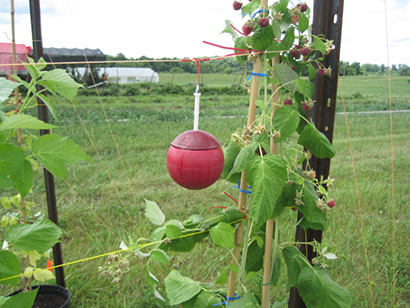Mar 7, 2017Attracticidal sphere lures spotted wing drosophila to their demise
It looks like a fruit, but it’s definitely not as healthy.
According to Entomology Today, it’s the attracticidal sphere, and a new study shows it to be a promising tool for managing the invasive fruit fly Drosophila suzukii. Published in the Journal of Economic Entomology, the research experiment found the attract-and-kill method, previously developed by the late Ron Prokopy and his graduate students at the University of Massachusetts to manage apple maggot (Rhagoletis pomonella) in orchards, to be similarly effective as a tool against D. suzukii in raspberry fields.
Lead author Kevin Rice, Ph.D., a post-doc at the U.S. Department of Agriculture-Agricultural Research Service Appalachian Fruit Research Station, in the lab of Tracy Leskey assembled the attracticidal sphere – which get their name from combining both an attractant and an insecticide – using a plastic base and a domed top made from a mixture including sugar feeding stimulant, wax, red dye, and insecticide. They first tested more than a dozen different insecticides in the sphere tool in the lab, and then they tested the spheres using the most effective insecticides (dinotefuran, spinetoram, spinosad, permethrin, and lambda-cyhalothrin) in the field.
“In the field, raspberry plants bearing ripe fruit were protected equally well by attracticidal spheres or weekly insecticide sprays when all ripe fruit was harvested at a weekly interval,” said Rice. “Moreover, when insecticide applications were coupled with attracticidal spheres, protection was increased, likely because spheres continue to kill flies dispersing into the crop between spray events.”
In their article, the researchers note that the weekly harvesting of ripe fruit should be combined with the use of the attracticidal spheres, which have shown in other studies to be less effective at high levels of pest presence. When more fruit is left on the plant, it is exposed longer and serves as more competition for the spheres in attracting the attention of D. suzukii, which is also known as spotted wing drosophila (SWD).
“Attracticidal spheres can help manage SWD infestations while reducing pesticide applications, non-target effects, and secondary pest outbreaks,” says Rice. “However, like most behaviorally based management strategies, attracticidal spheres will likely be most effective under low to moderate SWD population pressure. When SWD densities are extremely high, other strategies such as more frequent harvesting of ripe fruit as well as conventional insecticide applications will be necessary as well, though attracticidal spheres can provide an additional mechanism for managing this pest.”
Rice says ongoing research is examining the optimal placement of attracticidal spheres within plants and in fields to manage D. suzukii as well as the longevity of the spheres through exposure to sunlight and rainfall.















